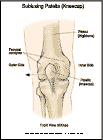
Patellar (Kneecap) Subluxation
What is a subluxing patella?
A subluxing patella (kneecap) is a temporary, partial dislocation of the kneecap from its normal position in the groove in the end of the thigh bone (femur). This groove is located between two bumps at the end of the thigh bone called the femoral condyles.
How does it occur?
This temporary dislocation of the kneecap usually happens during forced leg straightening, with the kneecap moving out of the groove to the outer side of the knee.
The cause is usually an abnormality in the way your legs are built. You may have an underdevelopment of the inner thigh muscle or an overdevelopment of the outer thigh muscle. Your kneecap may be higher in the leg than usual. You may be knock-kneed or have underdevelopment of the outer (lateral) femoral condyle.
What are the symptoms?
You may feel the kneecap moving out of position. You may have swelling and pain behind the kneecap. You may have pain when you bend or straighten your leg.
How is it diagnosed?
Your health care provider will ask about your symptoms and examine your knee. He or she may be able to feel the kneecap slipping to the outside as you bend and straighten your leg. An x-ray may show underdevelopment of the lateral femoral condyle.
How is it treated?
Treatment may include:
- putting ice packs on your knee for 20 to 30 minutes every 3 to 4 hours for the first 2 or 3 days or until the pain goes away
- elevating your knee to help any swelling go away
- taking an anti-inflammatory medication
- wearing a brace prescribed by your health care provider to keep your kneecap in place
- doing exercises to strengthen the inner side of the thigh muscle (quadriceps).
Some people need surgery to keep the kneecap from subluxing.
While you are recovering from your injury you will need to change your sport or activity to one that will not make your condition worse. For example, you may need to bicycle instead of run.
When can I return to my sport or activity?
The goal of rehabilitation is to return you to your sport or activity as soon as is safely possible. If you return too soon you may worsen your injury, which could lead to permanent damage. Everyone recovers from injury at a different rate. Return to your sport or activity will be determined by how soon your knee recovers, not by how many days or weeks it has been since your injury occurred. In general, the longer you have symptoms before you start treatment, the longer it will take to get better.
You may safely return to your sport or activity when, starting from the top of the list and progressing to the end, each of the following is true:
- Your injured knee can be fully straightened and bent without pain.
- Your knee and leg have regained normal strength compared to the uninjured knee and leg.
- Your knee is not swollen.
- You are able to jog straight ahead without limping.
- You are able to sprint straight ahead without limping.
- You are able to do 45-degree cuts.
- You are able to do 90-degree cuts.
- You are able to do 20-yard figure-of-eight runs.
- You are able to do 10-yard figure-of-eight runs.
- You are able to jump on both legs without pain and jump on the injured leg without pain.
If you develop pain, swelling, or the feeling that your kneecap is moving out of place again, you need to contact your health care provider.
How can I prevent a subluxing kneecap?
A subluxing kneecap is best prevented by keeping your thigh muscles strong, especially the group of muscles on the inner side of the thigh.

